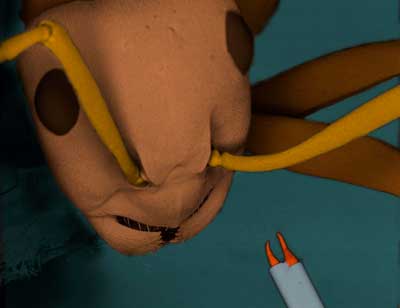| Jul 15, 2020 | |
The smallest micro-gripper, grown on optical fibers, is operated remotely with light(Nanowerk News) Researchers at the Faculty of Physics, University of Warsaw, used liquid crystal elastomer technology to demonstrate a series of micro-tools grown on optical fibers. The 200-micrometer gripers are controlled remotely, without electric wiring or pneumatic tubing, with green light delivered through the fibers - absorbed light energy is directly converted into the gripper jaws' action (Advanced Materials, "Optical Pliers: Micrometer-Scale, Light-Driven Tools Grown on Optical Fibers"). |
|
| Gripping objects is a fundamental skill for living organisms, from the microscopic rotifers, through the amazing dexterity of the human hand, to the jaws of predatory whales and soft tentacles of giant squids, and is also vital for many ever-shrinking technologies. Mechanical grippers, powered by electric, pneumatic, hydraulic or piezoelectric servos, are used at scales down to millimeters, but their complexity and need for force transmission prevent miniaturization. | |
| Researchers at the Faculty of Physics at the University of Warsaw with colleagues from the AGH University of Science and Technology in Cracow, Poland have now used liquid crystal elastomer microstructures that can change shape in response to light to build a light-powered micro-tool - optical pliers. The device was built by growing two bending jaws on the tips of hair-sized optical fibers. | |
 |
|
| The optical pliers next to the mandibles of a Formica polyctena ant for comparison (composite scanning electron microscope (SEM) image with added colors). The two jaws (red) close when light is sent through the optical fibers (light blue) that have the diameter of 125 microns, comparable to the diameter of a human hair. (Image: University of Warsaw) | |
| Liquid Crystalline Elastomers (LCEs) are smart materials that can reversibly change shape under illumination with visible light. | |
| In their prototype, scientists combined the light-powered LCEs with a novel method of fabricating micrometer-scale structures: when UV light is sent through the optical fiber, a cone-shaped structure grows at the fiber tip. | |
| The light-induced mechanical response of thus grown micro-structure depends on the orientation of molecules inside the elastomer element and can be controlled to get bending or contracting micro-actuators. | |
| The new elastomer growth technique readily offers a variety of micrometer-scale, remotely controlled functional structures - building blocks for the micro-toolbox. |
| Source: University of Warsaw | |
|
Subscribe to a free copy of one of our daily Nanowerk Newsletter Email Digests with a compilation of all of the day's news. |
